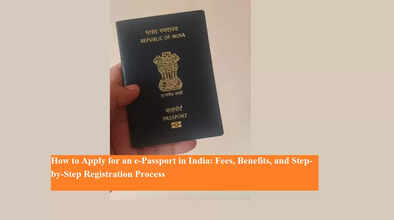How to Apply for an e-Passport in India: Fees, Benefits, and Step-by-Step Registration Process

The Government of India has officially introduced the e-Passport service under the Passport Seva 2.0 program, adding a smart and secure layer to the country’s traditional passport system. While currently available at select passport offices, the service will soon be rolled out nationwide, making it accessible to millions of travelers.
At first glance, an e-Passport looks almost identical to a regular passport. However, it can be distinguished by a small golden symbol on its cover, located just below the title. Behind this simple design lies advanced technology that promises stronger security, faster processing, and reduced chances of fraud.
What is an e-Passport?
An e-Passport is an upgraded version of the conventional passport. It is embedded with a contactless RFID chip and antenna, which digitally stores critical information such as your:
-
Personal details (name, date of birth, passport number)
-
Photograph
-
Fingerprints
-
Iris scan
The chip ensures secure, encrypted storage, making it extremely difficult to forge or tamper with. In addition, it complies with International Civil Aviation Organization (ICAO) standards, meaning it will be recognized and accepted at airports worldwide.
Key Benefits of an e-Passport
Choosing an e-Passport over the traditional version provides several advantages:
-
Enhanced Security: With biometric and encrypted data stored in the chip, the risk of misuse or forgery is minimized.
-
Faster Immigration: Digital verification speeds up the identity-checking process at airports, reducing wait times.
-
Global Recognition: ICAO-compliant design ensures smoother processing at international checkpoints.
-
Data Protection: Your personal information is securely stored and resistant to unauthorized access.
-
Reduced Fake Passport Risks: The advanced technology makes counterfeiting highly unlikely.
For frequent travelers or those seeking quick clearances at airports, an e-Passport is a valuable upgrade.
e-Passport Fees in India
The Ministry of External Affairs has set different fees depending on the type of booklet:
-
36-page e-Passport booklet: ₹1,500 (normal process)
-
60-page e-Passport booklet: ₹2,000 (normal process)
-
Tatkal option: Additional charges apply for expedited processing.
While slightly more expensive than standard passports, the added security and convenience make it worthwhile.
Step-by-Step Process to Apply for an e-Passport
Applying for an e-Passport is simple and largely follows the same process as a regular passport:
-
Visit the Official Portal: Go to the Passport Seva website.
-
Create/Login to Your Account: Register as a new user or sign in if you already have an account.
-
Fill in the Application Form: Select the e-Passport option and complete the online form with accurate details.
-
Choose a Center: Pick your nearest Passport Seva Kendra (PSK) or Post Office Passport Seva Kendra (POPSK).
-
Pay the Fees Online: Make the payment through the available online methods.
-
Book an Appointment: Schedule your visit to the selected passport center.
-
Attend the Appointment: Carry required documents and complete biometric verification at the PSK/POPSK.
Once processed, your e-Passport will be delivered to your registered address.
Why Opt for an e-Passport Now?
India launched e-Passports as part of its modernization efforts to improve travel convenience and security. Introduced as a pilot project in April 2024, the scheme is gradually expanding across the country. For people traveling abroad frequently, or for those applying for a new passport, opting for an e-Passport provides long-term benefits.
By combining technology with efficiency, the e-Passport represents the next step in making global travel safer, smoother, and faster for Indian citizens.

